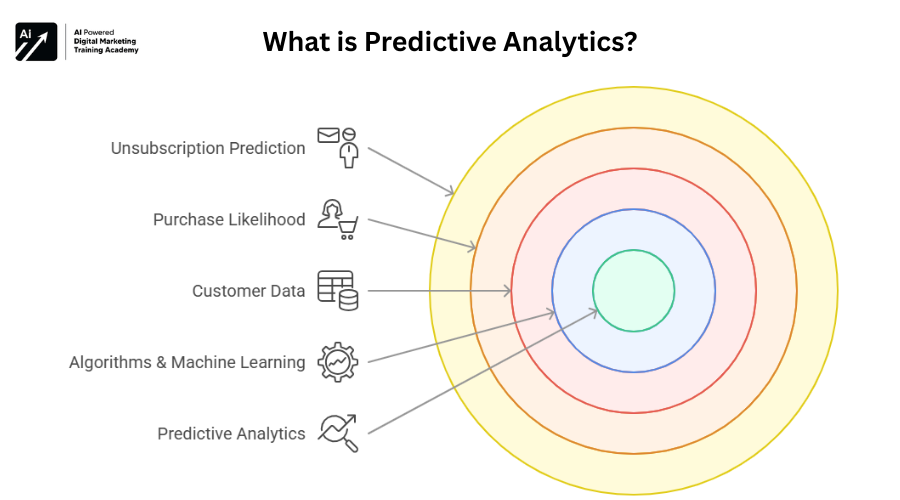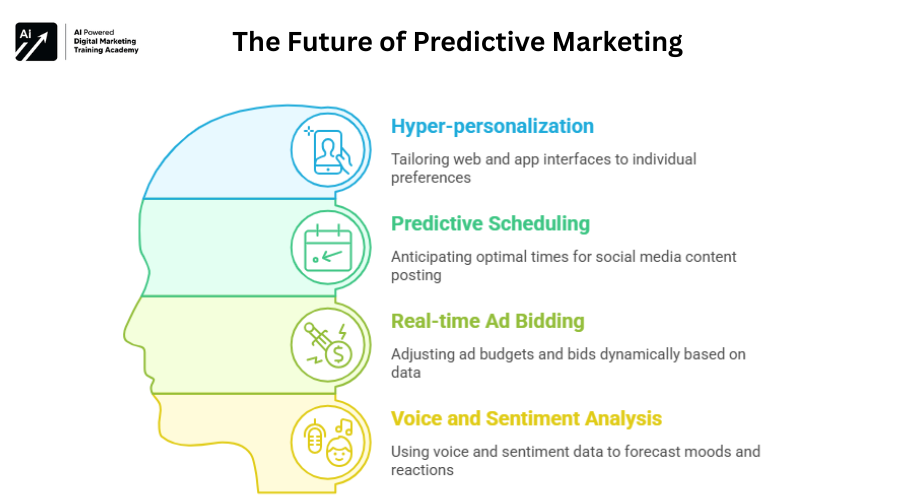There are no items in your cart
Add More
Add More
| Item Details | Price | ||
|---|---|---|---|
Sun Jun 1, 2025
The modern-day digital business landscape is a competitive landscape, and it's not just about knowing your customer but also being in a position to predict what they will need, when they will need it, and how they will need it. That's where predictive analytics comes in.
Knowing Predictive Analytics for Marketing isn't an option anymore. It is a necessity for companies wanting to remain ahead of the curve, amaze customers, and achieve maximum ROI. This blog gives a plain, technical-free description of what predictive analytics is, the way it works, and how it's revolutionizing marketing today.

In real life, predictive analytics is the method of applying algorithms, machine learning, and data to predict future behaviors from the past.Imagine it as kind of like weather forecasting but for customer behavior Just like how meteorologists apply patterns to forecast rain, businesses apply customer data to forecast such things as:
Marketing used to be all about reacting to customer behavior. You’d wait for a campaign to finish, look at the results, and then adjust your next one.No longer.With predictive analytics, marketers can respond in real time or even ahead of time. That translates to better timing, more relevant messaging, and more efficiency.
Here's why it's a game-changer:
Let's proceed step-by-step:
It begins with gathering data a whole bunch of it. This entails:
After they are collected, the data is purified and processed. Trends are determined using applications such as data mining, regression analysis, and machine learning models.
Historical data is used to build forecasting models to predict what happens in the future. For instance:
Models are implemented into marketing platforms. With each incoming piece of new data, the model learns and makes updated predictions so marketers can respond with urgency.
This is how predictive analytics knowledge in marketing allows brands to effect a shift from reactive to proactive marketing.
Did you ever realize Amazon displays "Customers who bought this also bought…" for you? That's predictive analytics in action. Amazon applies your purchasing and browsing history to anticipate what you will soon buy.
Netflix employs watching habits to suggest shows that are personalized to particular customers. The more one watches, the more intelligent it is.
Email software such as Mailchimp or HubSpot apply predictive analytics to determine when and with which subject lines to send emails in order to work best for a given segment.
Applications such as Salesforce and Zoho CRM apply predictive scoring so that sales teams can concentrate on top-performing leads.
These examples highlight the real business value of knowing predictive analytics in marketing and how it can deliver improved user experiences and business results.
Now that you know the basics, here is a closer look at what predictive analytics can do for your marketing:
No longer one, monolithic campaign. Predictive analytics lets you personalize offers to customer behavior, preference, and buying stage.
Budget your spending to statistically more successful channels, audiences, and strategies.
Mail when users are most engaged, tweet when users are most apt to see your tweets, and display ads that are actually relevant.
Leverage facts to discover long-term customer behaviors and repeat those successes with others.
Companies that employ predictive analytics are able to find trends sooner, act sooner, and beat the competition.
It's not difficult to understand how being familiar with predictive analytics in marketing isn't merely helpful it's about surviving today in the digital world.
If you’re ready to get started, there are many tools that bring predictive analytics to life for marketers:
Predictive analytics is strong, but it's not magic. A few things to keep in mind:
If the input data is erroneous or incomplete, your predictions are going to be bad. Clean, fresh, and rich data is needed.
Gathering and utilizing personal information does not happen without responsibility. Ensure that your strategies are GDPR, CCPA, and other data privacy regulation compliant.
Marketers need to be trained, even with programs, to interpret forecasting results and marry them with strategy.
Customer habits change. Your forecast models need upkeep in order to remain useful.In spite of these challenges, businesses that invest in learning and using predictive analytics to their advantage have an intimidating advantage.

Artificial intelligence, machine learning, and big data continue to change, and predictive analytics will become even more accurate and simple to use.We can anticipate:
Which is why getting smart about predictive analytics in marketing now is like purchasing prime property for pennies on the dollar. It sets you up for long-term success and expansion.
Predictive analytics is not data and algorithms predictive analytics is knowing your customer like never before and acting on that to act smart and quick.If you're not convinced yet, begin with small steps. Apply predictive tools in ad targeting or email marketing. Gradually, as you become more experienced, proceed with lead scoring and retention strategies.
Lastly, here's why spending time learning predictive analytics in marketing is a game-changer:
The sooner you implement predictive analytics, the sooner your marketing will move from trial and error to expansion.

Venkat
A California-based travel writer, lover of food, oceans, and nature.